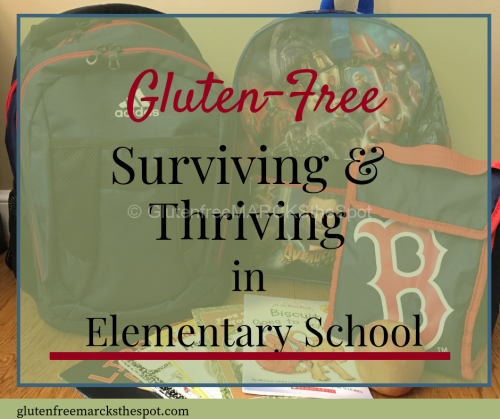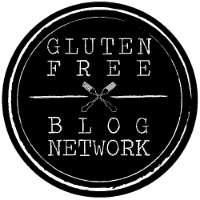Summer is over and school is now in session!
You beam with pride at your child starting the school year . . . then uncertainty creeps in when sending your child off with a gluten allergy.
Is your gluten-free child ready
for a safe school year?
Thankfully, through the elementary ages, children have the ability to better understand their gluten allergy or intolerance.
It’s beneficial to explain things in more detail and teach your child what can and cannot be eaten or used, such as certain craft items.
Reviewing at home is essential.
Teaching your children to be mindful of what they eat, and how they feel after they eat, are also important to implement.
This age group can also read packages to learn what foods to choose.
Make it into a game to read along with pre-readers and point out labels so they start to recognize gluten-free options on their own.
Today many schools are more understanding with peanut and nut allergies and have safety rules in place.
Other food allergies, including gluten, need to be explained. For example, many don’t realize that gluten can be found in craft items used within the classroom.
Speak up when you start
It’s beneficial to schedule a time to talk to the teacher and discuss possible issues within the classroom.
Explain how important it is to know when food will be used in the classroom (if allowed), so you can send in a safe gluten-free replacement. There is always something to substitute for your child to participate.
Here, you need the cooperation of the teacher.
A child with a food allergy/intolerance
should NEVER mean
exclusion from an activity
Be specific on how you would like certain situations handled at school per your child’s needs.
Typically I’ll print out a page regarding what my child can/can’t eat, and what he can /cannot participate in within the class.
For example, I explain that play dough is made with gluten. My child may use the play-dough but needs to wash his hands completely afterward.
This would not work with younger children as they typically put their hands, or the play-dough, in their mouth. I may share how to make safe gluten-free play-dough at home to use in the classroom.
Open communication is key.
If you have any issues with the teacher, reach out to the principal. Your child’s health and safety at school are important.
Forms can keep all on the same page
The school, or nurse in particular, will have important health forms to be filled out for your child.
Be sure to fill out the pages that pertain to your child’s issues. This keeps everyone on the same page and is typically shared with the teachers working with your child.
In some schools, this may be the Individual Health Care Plan or possibly a 504 plan.
Your input will be needed, as well as time to attend meetings each year. This is your right as a parent.
As a former teacher and school administrator, I have sat in dozens of these meetings setting up individual plans for children. They can be very beneficial for the student, teacher, parent and school.
This sets everyone up for success when the child needs extra steps to warrant a safe and effective learning environment at school.
Noting the Difference
In their article, “School Health Care Plans for Your Child with Food Allergies”, The Kids with Food Allergies Organization, states that “An IHCP addresses what the school will do to establish and maintain a safe school environment for the food allergic child. For example, an IHCP will detail what measures the school team will take to reduce the risk of allergen exposure, recognize symptoms of an allergic reaction and promptly intervene with the appropriate treatment. An IHCP is typically not a legally binding document.”
A 504 plan can help ensure a safe gluten-free environment for your child that is legally binding.
The School Health Care Plan article also states, “A 504 Plan is a contract between a school and a student. Having a 504 plan in place is particularly important when any concerns exist with regard to effective food allergy management, such as lack of a full-time nurse, limited school resources, or lack of effective policies and procedures.
The 504 Plan takes its name from Section 504 of the Rehabilitation Act of 1973, a federal law that prohibits schools that receive federal funding from excluding or otherwise discriminating against a student with a “disability” solely on the basis of that disability.
A “disability” under Section 504 is defined by the Americans with Disabilities Amendments Act (ADAA) as a “physical or mental impairment which substantially limits one or more major life activities.”
A “major life activity” includes walking, seeing, hearing, speaking, breathing, learning, working as well as eating.”
You can read more about 504 plans here at Celiac.org and GreatSchools.org
Either plan can be a safe bet for your school.
By law, the school needs to make safe modifications for your child.

Lunchtime
Elementary school typically means lunch at school. Being gluten-free, your safest bet is to send in your child’s lunch each day.
In this manner, you will know what your child has eaten, with less worry about reactions while in school. This is especially important with younger children.
Taking their own lunch to school is a great way to have your child eating a healthy lunch, and learning to make healthier choices. Not to mention, it is also cost-effective. (Check out How to Survive Your Gluten-Free School Lunch here)
To Eat or Not To Eat at School
Many schools are improving their cafeteria food choices. Yet, others have a long way to go and still serve unhealthy options to our children.
While the cafeteria may offer a gluten-free choice, they may not understand good cross-contamination practices. This could still cause your child to have a reaction or get sick while at school.
If you do choose to have your child eat in the school cafeteria, it’s beneficial to talk to the Food Service staff. They’ll explain safe options for your child, how the food is prepared (in a safe manner following rules for cross-contamination?), and when gluten-free options will be served.
Again, your best bet is open communication. Do not be afraid to ask all questions you have for the cafeteria before allowing your child to purchase lunch at school.
What Will Your Child Eat
It’s important to have open communication with your child on what they are eating at school as well.
Gluten-free children need to understand that trading foods or trying new foods at school can be harmful.
This is one of those times when they should NOT share. They may see something a friend has and want to eat it to fit in with others. Typically, you can find a safe, gluten-free alternative.
If you’re like my family, we’re often recreating recipes at home by making our own version. (Let me know if you need some help with this.)
Unfortunately, there are times when children at the elementary age will eat that forbidden food since mom and dad are not there watching. But, hopefully, they will learn from this and not try it again.
Be watchful if your child comes home sick a lot, possibly with belly aches, or running to the bathroom too often, causing missed school.
Make sure your child is not “manipulating his allergy” to get out of school, which can unfortunately happen.
New School Rules
Over the years schools have changed quite a bit as allergies have become more common.
Some elementary schools do not allow any food to be used in the classrooms, even for class parties.
This rule upsets some parents. Yet, I believe more would be accepting of this rule if they had a better understanding of food allergies and intolerances. Most do not understand how severe this issue can be until they experience it themselves.
If your school needs updating on their rules, bring this up with the PTO, principal or health committee at your school.
Be the change!
Explain and share what makes a safe gluten-free elementary experience.
If you work with your child’s teacher and are proactive, your child will have a great experience and not feel left out due to their gluten allergy.
Lack of communication usually results in hurt feelings for the child, which is not something any of us want our child to go through at any time.
Open communication between your child, the school, and your family is important to have a fabulous, safe and healthy school year.















